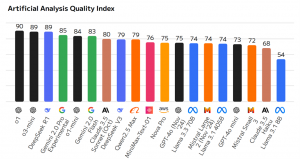How DeepSeek Shook Up the Tech Industry
Sheamus Finnegan
Tech Writer
Artificial Intelligence is a crucial front in the struggle for global hegemony fought by the United States and China. Until this January, the US has undisputedly held the lead in this race, largely due to its access to the most recent and most powerful chips produced by Taiwan Semiconductor. These chips are crucial for the training and developing of large language models such as ChatGPT or Gemini. That is until a small Chinese startup proved otherwise. The release of DeepSeek-R1, marketed as a lower-cost alternative to the most prominent models such as ChatGPT, shook the technology industry upon its release on Jan. 20. On Jan. 27, a week after DeepSeek-R1’s release, Chip giant Nvidia suffered a record one-day loss of 17%, equaling roughly $593 billion. On the same day, the S&P fell by 1.5%.

DeepSeek was developed by the parent company High-Flyer, a Chinese hedge fund that focuses on AI research and implements AI-based investment strategies. While large American tech companies such as OpenAI focus mainly on creating AI products for consumers, High-Flyer takes a different approach. Using profits from their hedge fund, High-Flyer funded years of AI research, almost completely forgoing the production of consumer-facing products. This approach had multiple advantages. First, it allowed for an environment of creative freedom in which, according to DeepSeek CEO Laing Wenfeng, there was “little discussion of commercial applications.” Second, it allowed the developers to avoid the strict regulations that the Chinese government has placed on the development of public AI products. Since High-Flyer focused solely on research and not the production of public products, they were able to fly under the radar.
The creative freedom afforded by this approach has allowed High-Flyer to create the advancement that sets DeepSeek apart from other large language models: its mixed-precision framework. DeepSeek’s custom FP8 mixed precision framework combines more expensive high-precision numerical formats, such as FP16 and FP32, with lower-precision formats that use less energy and computational power, such as FP8. The framework will apply FP8 to simple and non-essential computations while using FP16 and FP32 for more crucial tasks. This results in a model that is much more efficient in terms of both cost and energy.
OpenAI spent over $40 million training and developing GPT-4, while DeepSeek-V3 cost only four million. Despite being over six and a half times cheaper, DeepSeek’s performance has been shown to be comparable to – and in some cases, superior to – that of ChatGPT.

According to Artificial Analysis, a third-party company that tests the performance of different large language models, DeepSeek ranks above all other models in the categories of coding and quantitative reasoning, second in reasoning and knowledge, and third in the overall quality index.
It remains to be seen how DeepSeek will impact the world of AI in the long run. By releasing this cheap but efficient open-source model, DeepSeek has shown that the barriers to entry to compete with the likes of OpenAI are nowhere near as high as previously believed.
Contact Sheamus at sheamus.finnegan@student.shu.edu

